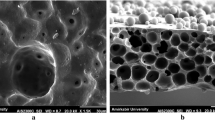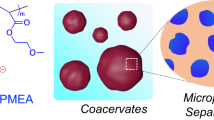Abstract
Self-assembly of amphiphilic block copolymers into well-ordered structures has attracted significant interest over the past decade. An especially attractive application of block-copolymer self-assembly is the formation of isoporous membranes. A major problem in this process is the lack of sufficient long-range order and the difficulty of up-scaling due to the time-consuming preparation steps. Here, we report an innovative and simple method to prepare isoporous membranes with nanometre-sized pores. The combination of the industrially well-established membrane formation method by non-solvent-induced phase separation with the self-assembly of a block copolymer is demonstrated. The result is the creation of an integral asymmetric membrane of a block copolymer with a highly ordered thin layer on top of a non-ordered sponge-like layer. This straightforward and very fast one-step procedure for membrane formation is reported for the first time. The developed membrane has the potential for highly selective separation.
This is a preview of subscription content, access via your institution
Access options
Subscribe to this journal
Receive 12 print issues and online access
$259.00 per year
only $21.58 per issue
Buy this article
- Purchase on Springer Link
- Instant access to full article PDF
Prices may be subject to local taxes which are calculated during checkout





Similar content being viewed by others
References
Whitesides, G. M. & Grzybowski, B. Self-assembly at all scales. Science 295, 2418–2421 (2002).
Ruzette, A. & Leibler, L. Block copolymers in tomorrow’s plastics. Nature Mater. 4, 19–31 (2005).
Stoykovich, M. P. et al. Directed assembly of block copolymer blends into nonregular device-oriented structures. Science 308, 1442–1446 (2005).
Cheng, J. Y., Mayes, A. M. & Ross, C. A. Nanostructure engineering by templated self-assembly of block copolymers. Nature Mater. 3, 823–828 (2004).
Bates, F. S. & Fredrickson, G. H. Block copolymers—designer soft materials. Phys. Today 52, 32–38 (1999).
Hamley, I. The Physics of Block Copolymers (Oxford Univ. Press, Oxford, 1998).
Abetz, V. & Simon, P. F. W. Phase behaviour and morphologies of block copolymers. Adv. Polym. Sci. 189, 125–212 (2005).
Krappe, U., Stadler, R. & Voigt-Martin, I. Chiral assembly in amorphous ABC triblock copolymers—formation of a helical morphology in polystyrene-block-polybutadiene-block-poly(methyl methacrylate) block copolymers. Macromolecules 28, 4558–4561 (1995).
Li, M., Coenjarts, C. A. & Ober, C. K. Patternable block copolymers. Adv. Polym. Sci. 190, 183–226 (2005).
Hillmyer, M. A. Nanoporous materials from block copolymer precursors. Adv. Polym. Sci. 190, 137–181 (2005).
Yang, S. Y. et al. Nanoporous membranes with ultrahigh selectivity and flux for the filtration of viruses. Adv. Mater. 18, 709–712 (2006).
Breiner, U., Krappe, U., Thomas, E. L. & Stadler, R. Structural characterization of the “knitting pattern” in polystyrene-block-poly(ethylene-co-butylene)-block-poly(methylmethacrylate) triblock copolymers. Macromolecules 31, 135–141 (1998).
Ott, H., Abetz, V. & Altstädt, V. Morphological studies of poly(styrene)-block-poly(ethylene-co-butylene)-block-poly(methyl methacrylate) in the composition region of the “knitting pattern” morphology. Macromolecules 34, 2121–2128 (2001).
Riegel, I. C. et al. Dynamics and structure of an amphiphilic triblock copolymer of styrene and 5-(N,N-diethylamino)isoprene in selective solvents. Pure Appl. Chem. 76, 123–131 (2004).
Gohy, J. F. Block copolymer micelles. Adv. Polym. Sci. 190, 65–136 (2005).
Nunes, S. P. & Peinemann, K.-V. (eds) Membrane Technology: In the Chemical Industry 2nd, revised and enlarged edn (Wiley-VCH, Weinheim, 2006).
Nunes, S. P. Recent advances in the controlled formation of pores in membranes. Trends Polym. Sci. 5, 187–192 (1997).
Shishatskiy, S. et al. Polyimide asymmetric membranes for hydrogen separation: Influence of formation conditions on gas transport properties. Adv. Eng. Mater. 8, 390–397 (2006).
Luxton, A. R., Quig, A., Delvaux, M. J. & Fetters, L. J. Star-branched polymers. 2. Linking reaction involving 2- and 4-vinyl pyridine and dienyl- and styryllithium chain ends. Polymer 19, 1320–1324 (1978).
Antonietti, M., Heinz, S., Schmidt, M. & Rosenauer, C. Determination of the micelle architecture of polystyrene/poly(4-vinylpyridine) block copolymers in dilute solution. Macromolecules 27, 3276–3281 (1994).
Förster, S., Zisenis, M., Wenz, E. & Antonietti, M. Micellization of strongly segregated block copolymers. J. Chem. Phys. 104, 9956 (1996).
Riess, G. Micellization of block copolymers. Prog. Polym. Sci. 28, 1107–1170 (2003).
Zha, W. et al. Origin of the difference in order–disorder transition temperature between polystyrene-block-poly(2-vinylpyridine) and polystyrene-block-poly(4-vinylpyridine) copolymers. Macromolecules 40, 2109–2119 (2007).
Clarke, C. J. et al. Measurements of the Flory–Huggins interaction parameter for polystyrene-poly(4-vinylpyridine) blends. Macromolecules 30, 4184–4188 (1997).
Matsen, M. W. & Bates, F. S. Unifying weak- and strong-segregation block copolymer theories. Macromolecules 29, 1091–1098 (1996).
Ikkala, O. & ten Brinke, G. Functional materials based on self-assembly of polymeric supramolecules. Science 295, 2407–2409 (2002).
Sidorenko, A., Tokarev, I., Minko, S. & Stamm, M. Ordered reactive nanomembranes/nanotemplates from thin films of block copolymer supramolecular assembly. J. Am. Chem. Soc. 125, 12211–12216 (2003).
Lin, Y. H. & Juang, J. H. Onset of entanglement. Macromolecules 32, 181–185 (1999).
Kim, S. H. et al. Highly oriented and ordered arrays from block copolymers via solvent evaporation. Adv. Mater. 16, 226–231 (2004).
Auschra, C. & Stadler, R. Synthesis of block copolymers with poly(methyl methacrylate)—P(B-b-MMA), P(EB-b-MMA), P(S-b-B-b-MMA) and P(S-b-EB-b-MMA). Polym. Bull. 30, 257–264 (1993).
Gauthier, S. & Eisenberg, A. Vinylpyridinium ionomers. 2. Styrene-based ABA block copolymers. Macromolecules 20, 760 (1987).
Zhu, J., Eisenberg, A. & Lennox, R. B. Interfacial behavior of block polyelectrolytes. 1. Evidence for novel surface micelle formation. J. Am. Chem. Soc. 113, 5583 (1991).
Bossé, F., Schreiber, H. P. & Eisenberg, A. Specific adsorption of some styrene vinylpyridine diblocks from selective solvents onto solid substrates—an NMR-study. Macromolecules 26, 6447–6454 (1993).
Acknowledgements
The authors thank B. Lademann for help in synthesizing the block copolymer, G. Johannsen for help in preparation of the films and M. Schossig and M. Aderhold for the SEM images. The authors are grateful to C. Abetz for the AFM and TEM investigations and A. Boschetti-de-Fierro for some helpful comments. This work was supported by the European Commission (project COMPOSE, contract NMP3-CT-2003-505633).
Author information
Authors and Affiliations
Corresponding author
Rights and permissions
About this article
Cite this article
Peinemann, KV., Abetz, V. & Simon, P. Asymmetric superstructure formed in a block copolymer via phase separation. Nature Mater 6, 992–996 (2007). https://doi.org/10.1038/nmat2038
Received:
Accepted:
Published:
Issue Date:
DOI: https://doi.org/10.1038/nmat2038
This article is cited by
-
Asymmetric block copolymer membrane fabrication mechanism through self-assembly and non-solvent induced phase separation (SNIPS) process
Scientific Reports (2022)
-
Nanostructured block copolymer muscles
Nature Nanotechnology (2022)
-
Comb like amphiphilic graft copolymers bearing PDMS and PEO side chains: synthesis and solvent assisted self-assembly behavior
Journal of Polymer Research (2022)
-
Artificial channels for confined mass transport at the sub-nanometre scale
Nature Reviews Materials (2021)
-
Breaking the permeability–selectivity trade-off in thin-film composite polyamide membranes with a PEG-b-PSF-b-PEG block copolymer ultrafiltration membrane support through post-annealing treatment
NPG Asia Materials (2019)



